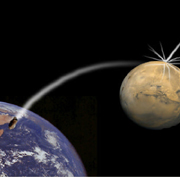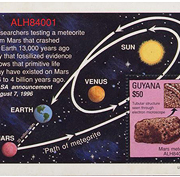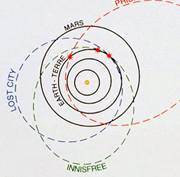Meteorite, Where Do You Come From?

Enlargement
Meteorite ejected from the planet Mars by an impact. |
All meteorites originate in our solar system. The object from which they have broken away is called the parent body. Most meteorites are fragments of asteroids located in the belt between Mars and Jupiter. These fragments may leave the asteroid belt after a collision or because of perturbations from the giant Jupiter. Afterwards, these asteroid fragments revolve around the Sun in very elliptical orbits. They may remain in space several millions of years before crossing the Earth's path.
Planets are the parent bodies of a small number of meteorites. Fragments of these parent bodies were hurled into space at the time of colossal impacts. So far, scientists have only identified meteorites that come from the planet Mars. Some meteorites might be from Mercury, but their origin has not yet been confirmed. We do not know enough about the precise composition of the surface of this planet to make a comparison. Some rare meteorites come to us from our nearest neighbour, the Moon.
Depending on the size of the celestial body they come from, meteorites have different crystallization ages. Meteorite fragments from the Moon and from Mars are younger than pieces of asteroids.
 |
| Enlargement |
| Stamp issued by Guyana in 1996. It commemorates the discovery of the Martian meteorite ALH 84001. The path the meteoroid took from Mars to Earth is shown. |
 |
| Enlargement |
| We have precise information about the orbits of a few meteoroids that have left the asteroid belt and crossed Earth's orbit. |
|